Adopting a gluten-free Mediterranean diet offers a unique approach to eating that emphasizes the consumption of vegetables, fruits, legumes, and healthy fats, while eliminating the gluten found in grains like wheat, barley, and rye. This dietary pattern is associated with numerous health benefits including lower risks of heart disease and inflammation. A vegetable-forward meal plan under this diet focuses on using fresh, seasonal produce as the star of the plate, providing both nutrition and flavor without reliance on gluten-containing ingredients.

Choosing to eat vegetable-forward meals on a gluten-free Mediterranean diet can be both delightful and nourishing. Breakfast might feature a bright vegetable frittata, while lunches and dinners can be built around hearty legume stews, vibrant salads, and grilled vegetables paired with lean proteins like fish. Swapping traditional grains with gluten-free alternatives such as quinoa or buckwheat ensures that meals are diverse and satisfying. Thoughtful preparation and the incorporation of a variety of vegetables can keep meals interesting and palatable.
Key Takeaways
- Embracing a gluten-free Mediterranean diet prioritizes vegetables and minimizes gluten without sacrificing flavor or nutrition.
- Meal planning on this diet encompasses refreshing breakfasts, vibrant lunches, and satisfying dinners, focusing on plant-based ingredients.
- Gluten-free grains such as quinoa serve as excellent substitutes, ensuring varied and texture-rich culinary experiences.
Table of Contents
Understanding Gluten-Free Mediterranean Diet
The gluten-free Mediterranean diet merges the rich variety of plant-based, heart-healthy foods traditionally consumed in Mediterranean regions with the dietary needs of those avoiding gluten.
Basics of Gluten-Free Eating
Adopting a gluten-free diet necessitates the exclusion of gluten, a protein found in wheat, barley, rye, and their derivatives. For individuals with celiac disease or gluten sensitivity, this is critical. However, a gluten-free lifestyle can be nutrient-dense and flavorful with careful planning. Key staples include:
- Fruits and Vegetables: They are inherently gluten-free and form the cornerstone of the diet.
- Whole Grains: Options like quinoa, brown rice, and millet replace traditional gluten-containing grains.
- Proteins: A focus on lean meats, fish, and legumes provides essential nourishment without gluten.
- Healthy Fats: Olive oil is emphasized for its health benefits and gluten-free status.
Benefits of Mediterranean Eating Patterns
The Mediterranean diet emphasizes:
- Diverse Vegetables: They offer antioxidants and are a main feature of every meal.
- Heart-Healthy Fats: Olive oil serves as the primary cooking fat; it’s linked to reduced heart disease risk.
- Whole Grains: In a gluten-free context, whole grains that do not contain gluten are used, supplying fiber and nutrients.
By combining these elements, one can maintain a balanced, gluten-free diet that supports overall well-being.
Starting Your Day Right
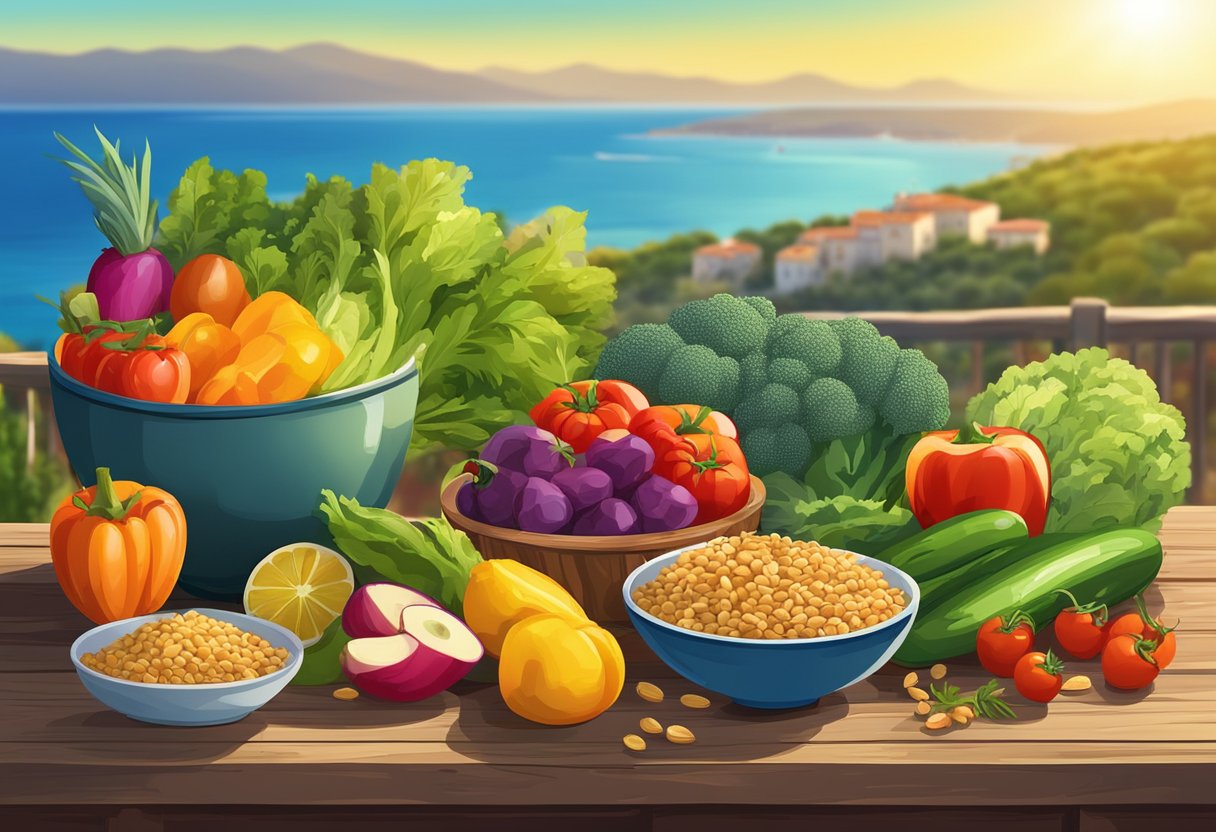
A nutritious breakfast sets the tone for the day, especially when following a gluten-free Mediterranean diet. Prioritize easy and quick recipes that incorporate vegetables, quinoa, oats, and are vegetarian friendly to kickstart a day of healthy eating.
Breakfast Bowls and Smoothies
Breakfast bowls are a stellar choice for those seeking a healthy, gluten-free start. Utilizing ingredients like quinoa and a medley of vegetables can create a satisfying and nutrient-packed meal. Quinoa, a versatile and protein-rich seed, serves as a perfect base for savory bowls, topped with poached eggs and sautéed greens. For a sweeter start, a quinoa fruit bowl, drizzled with a touch of honey, combines the hearty seed with fresh fruit.
Smoothies provide a quick and easy way to blend a variety of nutrients into a single glass. They excel in convenience while allowing for creativity. One can blend leafy greens like spinach with berries, unsweetened almond milk, and a scoop of gluten-free oats for added fiber, creating a drink that’s both satiating and energizing.
Gluten-Free Morning Bakes
Morning bakes can transform the breakfast experience with minimal effort. Starting with gluten-free flours, one can prepare bakes such as vegetable-laden frittatas or quiche filled with Mediterranean staples like tomatoes, olives, and feta cheese. These bakes are not only rich in nutrients but also adhere to a vegetarian, gluten-free regimen.
For those with a sweet tooth, gluten-free oat flour can be utilized to create delectable muffins and pancakes. Adding in ripe bananas, a dash of cinnamon, or a handful of nuts can enhance the flavor profile while keeping the recipes in line with Mediterranean diet principles. These bakes offer a convenient option as they can be made in advance and enjoyed throughout the week.
Light and Satisfying Lunches

Creating a light and satisfying lunch within a gluten-free Mediterranean diet framework focuses on incorporating fresh vegetables and wholesome proteins into each meal. These lunches aim to energize without the sluggishness that often follows a heavy midday meal.
Salads and Bowls
Salads and bowls offer a versatile foundation for a gluten-free Mediterranean lunch. One favored combination consists of kale and spinach, which provide a high-density nutrient base, particularly rich in fiber and antioxidants. Adding quinoa introduces a complete protein source, while toss-ins like cucumbers, tomatoes, and olives embody the heart of Mediterranean freshness. For a fiber boost, including chickpeas can add both texture and satiety.
- Mediterranean Quinoa Bowl: A base of fluffy quinoa topped with spinach, roasted red peppers, grilled zucchini, and a generous dollop of hummus.
Hearty Mediterranean Soups
Soups in a gluten-free Mediterranean diet infuse the warm comfort of a meal with a bounty of vegetables and legumes, making them surprisingly hearty. They often contain a blend of vegetables and proteins such as lentils or beans, thickened naturally without the need for gluten-containing products.
- Gluten-Free Minestrone: A rich tomato-based soup brimming with seasonal veggies, white beans, and herbs, finished with a swirl of extra virgin olive oil.
Gluten-Free Sandwich Alternatives
For those who crave the convenience of sandwiches, gluten-free Mediterranean diet adherents can explore an array of alternative options. Stuffed lettuce wraps or grilled eggplant slices can replace traditional bread, while still encapsulating the essence of the Mediterranean flavors.
- Chickpea Salad Lettuce Wraps: Tender chickpeas mixed with Mediterranean spices, sun-dried tomatoes, and crumbled feta cheese, all nestled in crisp lettuce leaves.
Delectable Dinners
The gluten-free Mediterranean diet offers an array of vegetable-forward dinners that are both satisfying and nourishing. With a focus on fresh veggies and wholesome substitutes, these meals are designed to delight the palate while adhering to dietary needs.
Vegetable-Centric Main Courses
Dinners on a gluten-free Mediterranean diet revolve around vibrant vegetables taking center stage. Recipes celebrate the natural flavor of seasonal produce, often requiring minimal ingredients to shine.
-
Oven-Roasted Veggies: A simple yet flavorful dish involves an assortment of vegetables—like bell peppers, zucchini, and cherry tomatoes—tossed in olive oil and herbs, then roasted to perfection. This method highlights the vegetables’ natural sweetness and provides a versatile side or main dish.
-
Eggplant Parmesan: Users may create a scrumptious, gluten-free version of this classic by using almond flour or gluten-free breadcrumbs for the breading. With layers of roasted eggplant, rich tomato sauce, and melted mozzarella cheese, every bite is a testament to the diet’s fulfilling yet healthy ethos.
Recipes focusing on vegetables not only offer nutrition but also cater to both vegetarian and vegan tastes, allowing them to be modified according to individual dietary preferences.
Gluten-Free Pasta Alternatives
Incorporating pasta alternatives keeps dinners exciting and adheres to the gluten-free requirements. Traditional pasta dishes are revamped with ingredients like:
-
Farro: An ancient grain, farro presents a hearty, nutty base for Mediterranean bowls, vibrant with grilled veggies and a drizzle of pesto or lemon vinaigrette. Although farro is not gluten-free, it can be substituted with quinoa or brown rice for those who need a strict gluten-free option.
-
Zucchini Noodles: These are a light and healthy substitute for pasta. When twirled into a bowl and topped with a fresh tomato sauce and grilled seafood, they make for a nutritious and delicious dinner that fits well within the guidelines of a gluten-free Mediterranean lifestyle.
Gluten-free pasta alternatives are not only healthy but also bring a creative twist to traditional Mediterranean fare, satisfying the longing for pasta without the gluten.
Sides and Small Plates
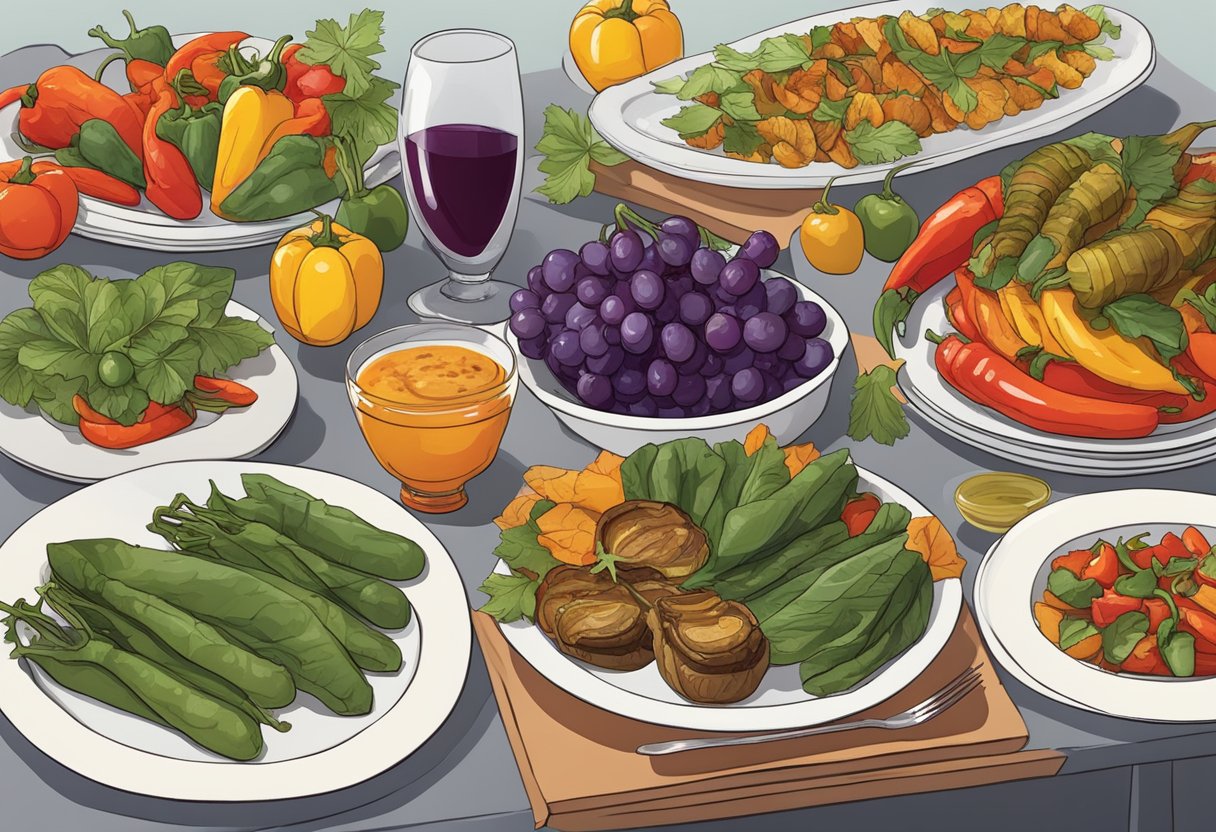
The gluten-free Mediterranean diet offers a diverse array of side dishes and small plates, each featuring vibrant vegetables and legumes. These dishes are not only flavorful but also contribute to a balanced diet with their nutritional benefits.
Vegetable Sides and Salads
One popular option for vegetable sides is a kale salad, often dressed with lemon and olive oil, and sometimes accented with slivers of parmesan for an extra layer of flavor. Another favorite is cauliflower rice, a versatile low-carb substitute for traditional grains, which can be sautéed with a mix of Mediterranean spices. For a quick and healthy addition to any meal, roasted chickpeas offer a delightful crunch and are a great source of protein.
- Kale Salad: Massage fresh kale with olive oil and lemon juice; add parmesan for a salty bite.
- Cauliflower Rice: Sauté ‘riced’ cauliflower with garlic, cumin, and coriander for a flavorful side.
Legume-Based Dishes
Chickpeas and black beans play a significant role in the Mediterranean diet, often featured in salads or as a small plate. A simple, yet satisfying dish can be created by combining these legumes with diced vegetables, herbs, and a zesty vinaigrette. For those looking to incorporate a plant-based source of protein into their meals, these legumes serve as an excellent choice.
- Chickpea Salad: Mix chickpeas with diced cucumbers, tomatoes, and a lemon-herb dressing.
- Black Bean Small Plate: Season black beans with paprika and garlic, serve warm with a side of gluten-free pita.
Snacks and Treats
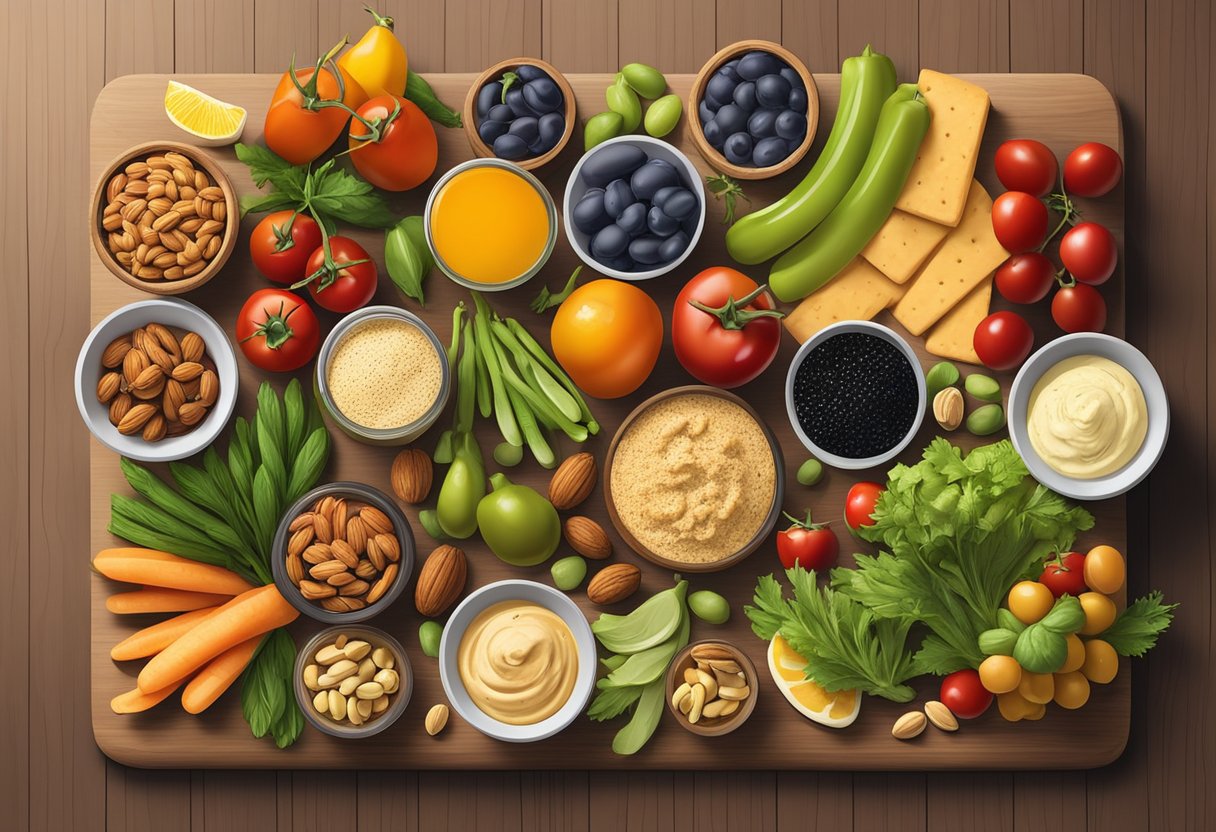
On a gluten-free Mediterranean diet, individuals can enjoy a variety of snacks and treats that are both nutritious and satisfying. These options often incorporate fresh fruits, vegetables, nuts, and seeds, ensuring that snacks are as healthy as they are delicious.
Healthy Snacking Options
For those seeking healthy snacking options, incorporating vegetables is key. Carrot sticks, cucumber slices, and bell pepper strips make for quick and easy snacks on the go. They can be paired with hummus or yogurt-based dips that are rich in protein and gluten-free. Nuts such as almonds and walnuts offer a crunchy, nutrient-dense snack high in healthy fats that can help keep one satisfied between meals.
- Vegetable sticks with hummus
- A handful of mixed nuts
Gluten-Free Treats and Sweets
When it comes to gluten-free treats and sweets, fruits play a significant role in the Mediterranean diet. Dried fruits like figs, dates, and apricots provide natural sweetness without the need for added sugars and are an excellent way to satisfy a sweet tooth. For a more indulgent yet health-conscious option, dark chocolate that is at least 70% cacao can be paired with nuts or fruits to make a delightful treat that adheres to a gluten-free diet.
- Dried figs and apricots
- Dark chocolate with almonds
Planning and Meal Prep
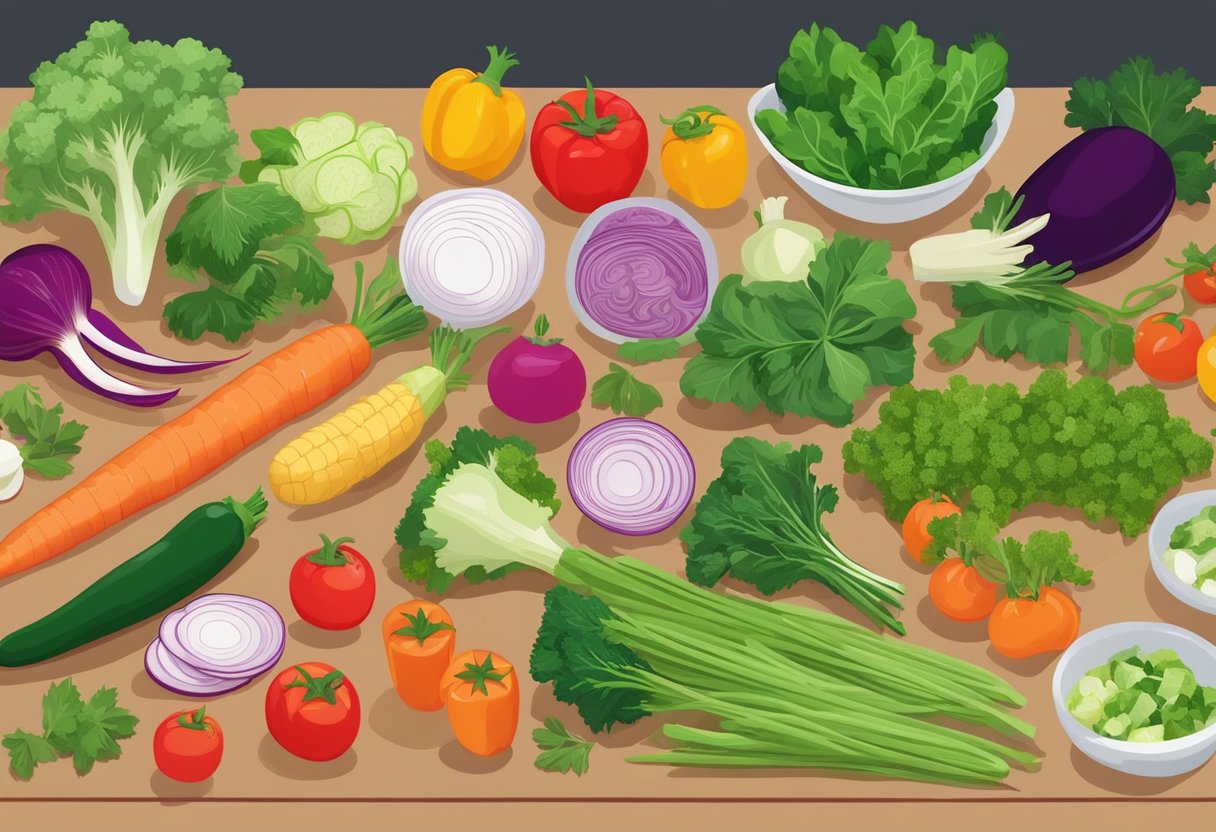
Effective planning and meal prep are foundational for maintaining a gluten-free Mediterranean diet that prioritizes vegetables. They establish a structure that not only saves time but also ensures a varied and flavorful diet.
Grocery Shopping Tips
One should craft a meticulous shopping list before heading to the store to streamline their grocery shopping. This list should be budget-friendly and vegetable-forward, prioritizing a variety of colorful veggies. They can take inspiration from Mediterranean diet guides that suggest purchasing ingredients like leafy greens, tomatoes, cucumbers, and peppers. By adhering to the list, they’ll avoid impulse buys and maintain a gluten-free pantry with ease.
- Fruits and Vegetables: Seasonal and local produce for freshness and cost savings.
- Lean Proteins: Chicken and fish for high-quality, Mediterranean-friendly protein sources.
- Healthy Fats: Items such as avocados, nuts, seeds, and high-quality olive oils.
- Gluten-Free Grains: Quinoa, rice, and certified gluten-free oats for diverse meal options.
Meal Prepping Strategies
When it comes to meal prep, the individual should focus on preparing versatile vegetable dishes that can be mixed and matched throughout the week. This approach simplifies the process, making it both easy and quick. For instance, roasting a large batch of Mediterranean-inspired vegetables such as zucchini, bell peppers, and eggplant can provide a healthy base for multiple meals. Utilizing kitchen tips such as proper storage techniques ensures that prepped meals maintain their freshness. Moreover, by preparing gluten-free grains in bulk and incorporating a variety of herbs and spices, they can enjoy a wealth of easy and quick-to-assemble meals.
- Chop and Store: Pre-cut vegetables for snacks and recipes to save time during the week.
- Batch Cooking: Prepare large quantities of grains and proteins to mix into meals.
- Herbs and Spices: Store a selection of these to add flavor diversity without extra calories.
Building a Balanced Plate
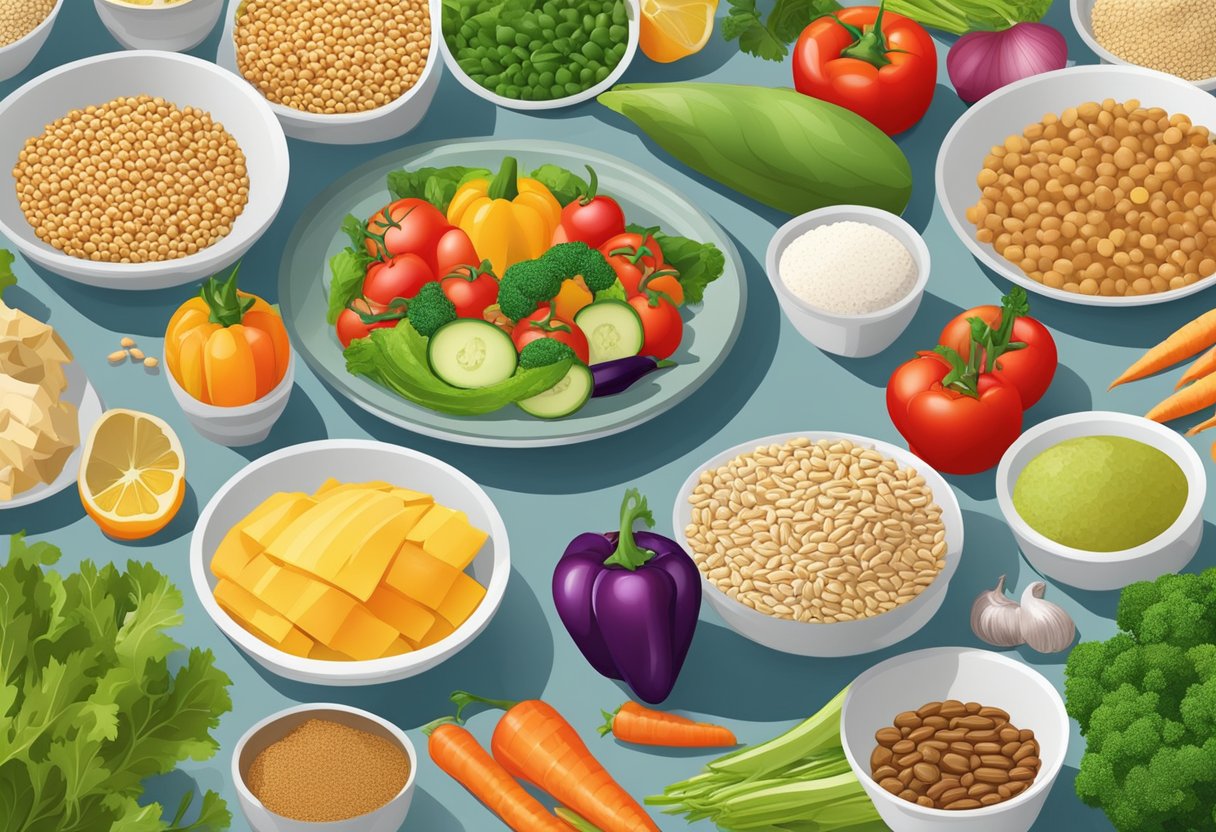
Creating a balanced plate in the context of a gluten-free Mediterranean diet involves careful consideration of nutrient diversity and meal composition. It emphasizes the importance of including a variety of food groups such as lean proteins, healthy fats, and fiber-rich vegetables, while managing portion sizes and meal timing to maintain a balanced diet.
Macro and Micronutrient Balance
When they design their meals, individuals should aim to include a range of macronutrients—carbohydrates, proteins, and fats—alongside essential vitamins and minerals. For a gluten-free Mediterranean approach, the focus is on complex carbohydrates from vegetables and gluten-free grains to provide adequate fiber. Protein can come from plant sources like legumes or high-quality animal sources, such as fish which also supply omega-3 fatty acids. Healthy fats are a cornerstone of this diet, with a particular emphasis on olive oil as a primary fat source due to its mono- and polyunsaturated fats, which can help maintain low levels of saturated fat.
Portion Sizes and Meal Timing
Portion control is a crucial aspect of a balanced diet. It ensures that they consume not only the right kinds of foods but also in appropriate amounts to avoid excessive caloric intake. Vegetables should fill half the plate, a quarter should consist of gluten-free grains or starchy vegetables, and the remaining quarter should be reserved for lean proteins. Regular meal timings promote better digestion and can help control blood sugar levels. Attention to sodium intake is necessary to prevent an increase in blood pressure, suggesting the use of herbs and spices for flavoring instead of salt.
Gluten-Free Ingredient Alternatives
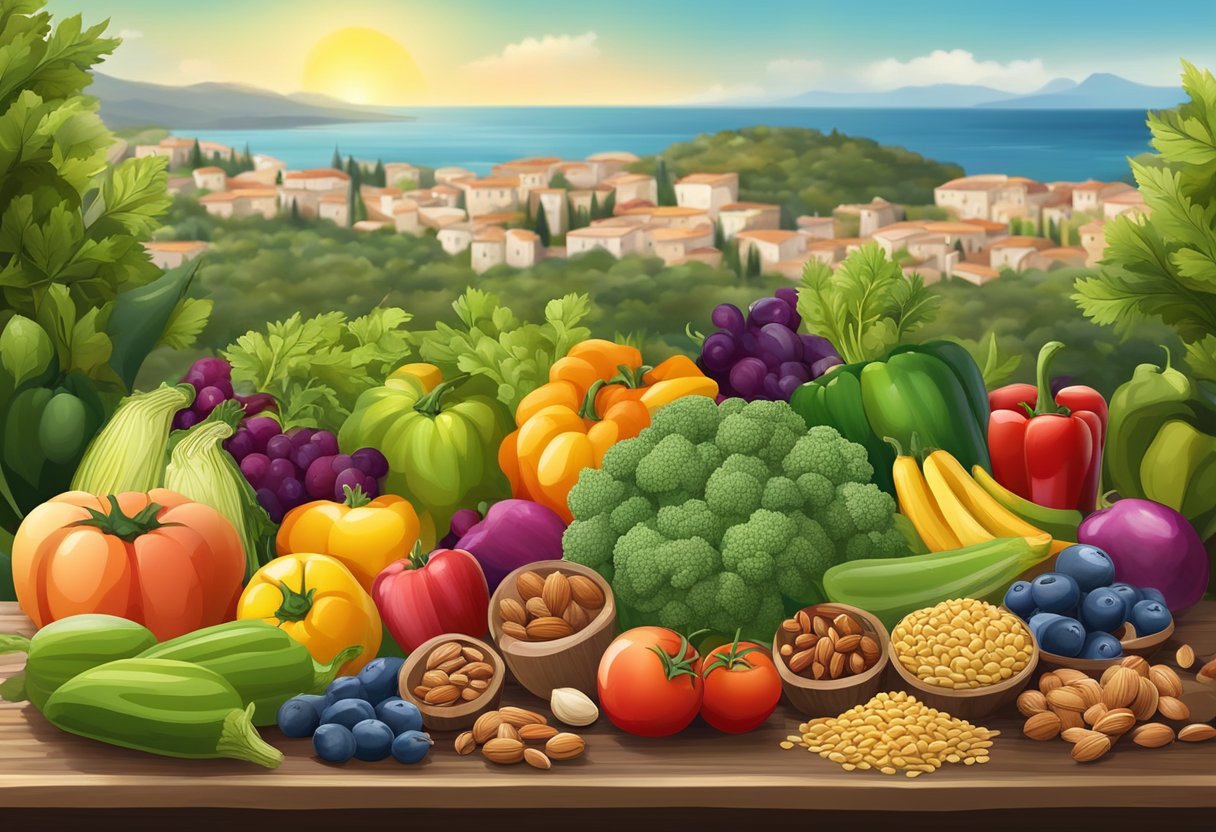
When adopting a gluten-free Mediterranean diet, one must consider suitable alternatives for common gluten-containing ingredients. Carefully selected replacements can ensure that dishes remain nutritious and flavorful while aligning with dietary restrictions.
Flours and Thickening Agents
Traditional Mediterranean recipes often call for wheat flour as a thickening agent. However, for those requiring gluten-free options, there are several alternatives:
- Almond Flour: A rich source of nutrients and flavor, almond flour can replace wheat flour at a ratio of 1:1 in most recipes.
- Coconut Flour: Highly absorbent and lending a mild, sweet taste to dishes, coconut flour may require an increased number of eggs or other binding agents to achieve the desired consistency.
Other gluten-free whole grains like rice flour and buckwheat can also serve as thickening agents, similarly to how they are emphasized in the Mediterranean diet.
| Gluten-Free Flour | Usage |
|---|---|
| Almond Flour | Baking, coating, general cooking |
| Coconut Flour | Baking, confections, sauces |
| Rice Flour | Thickening soups and sauces, breading |
| Buckwheat | Baking, noodles, pancakes |
Binders and Leavening Agents
Without gluten, creating the right texture in baking requires alternatives that offer similar binding properties.
- Flaxseed: Ground flaxseed mixed with water creates a viscous mixture that can serve as a binder in recipes. Not only is it gluten-free, but it is also rich in omega-3 fatty acids.
- Baking powder and baking soda remain staple leavening agents and are inherently gluten-free, making them ideal for use in a variety of Mediterranean diet-friendly recipes.
When using these alternatives, individuals should ensure they are labeled gluten-free, as cross-contamination during processing is common. Adapting the Mediterranean diet for gluten-free needs encourages the exploration of diverse, nutrient-rich foods, enhancing both variety and healthfulness.
Kitchen Techniques and Cooking Tips
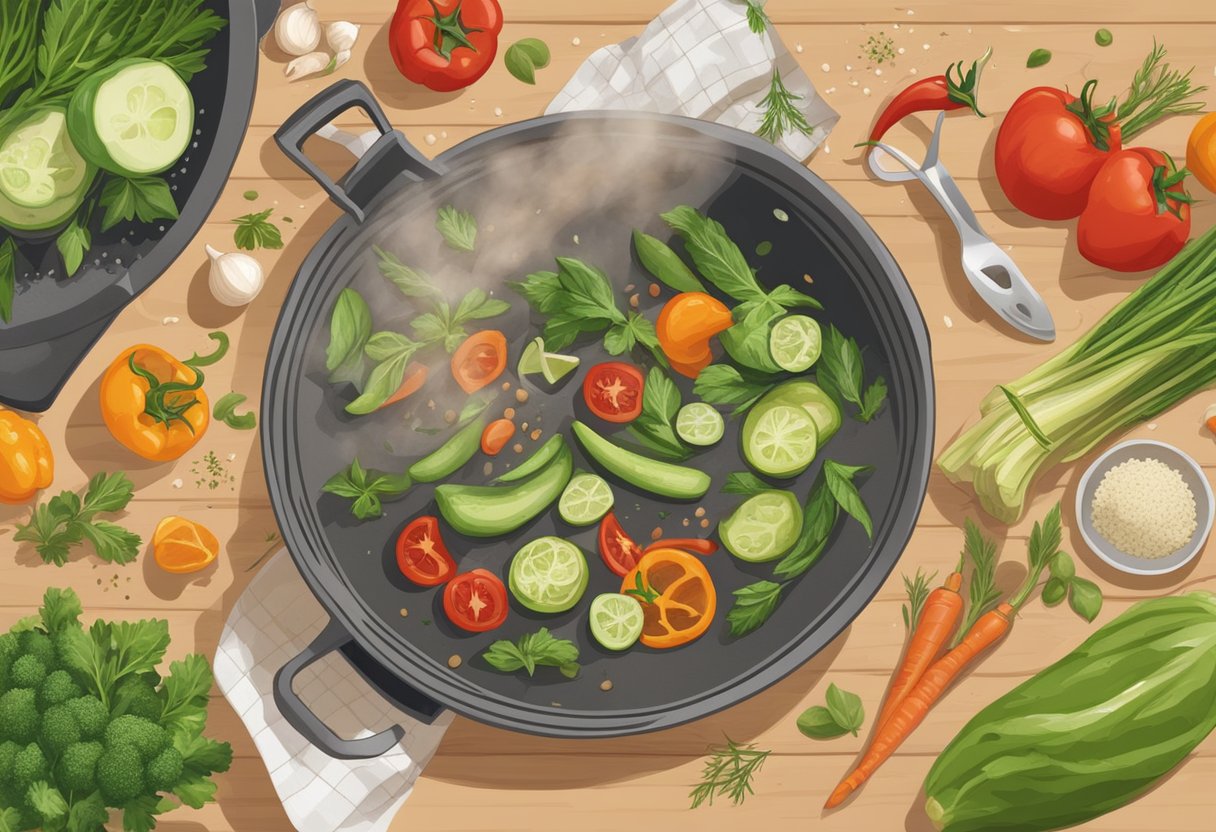
Mastering vegetable-forward meals within a gluten-free Mediterranean diet involves understanding the essentials of gluten-free cooking and the distinct flavor profiles that characterize Mediterranean cuisine.
Gluten-Free Cooking Basics
When preparing gluten-free meals, one must pay careful attention to ingredients and cross-contamination. Cooking from scratch is a recommended approach, as it allows for complete control over what goes into a dish. Key ingredients such as cornstarch or gluten-free flour blends can be used for thickening sauces or as a base for gluten-free bread and pizza dough. For pasta dishes, rice noodles or legume-based pastas offer excellent gluten-free alternatives that are both nutritious and align with the Mediterranean focus on plant-based ingredients.
- Essential gluten-free ingredients for the pantry:
- Gluten-free pasta (rice, corn, quinoa, or legume-based)
- Cornstarch or gluten-free all-purpose flour
- Gluten-free baking powder and baking soda
The use of parchment paper or separate cooking utensils can help to eliminate the risk of cross-contamination.
Mediterranean Flavor Profiles
Mediterranean cuisine is lauded for its vibrant and robust flavors, derived from a rich palette of herbs and spices. Essential to capturing the taste of the region is the use of olive oil, not just as a cooking medium but also as a flavor enhancer. Dishes often include a generous drizzle of high-quality extra virgin olive oil to finish. Lemon juice is another staple, providing a bright, acidic counterpoint to the richness of olive oils and helping to lift the flavors of vegetables and proteins.
- Mediterranean spices and seasonings typically used:
- Italian seasoning
- Garlic
- Oregano
- Basil
- Rosemary
- Thyme
- Sea salt
In gluten-free Mediterranean cooking, one must be mindful of spice blends; commercially prepared mixes may contain gluten as a filler or anti-caking agent. Preparation of homemade spice blends is recommended to ensure they are gluten-free and align with the desired flavors. Herbs and spices can be used in rubs for proteins, infused into oils, or tossed with roasted vegetables to impart a quintessentially Mediterranean flavor.
Expanding Your Vegetable Repertoire

Incorporating a variety of vegetables is crucial for a nutrient-rich, gluten-free Mediterranean diet. It ensures a feast of flavors and a rainbow of colors on your plate that align with seasonal and sustainable eating principles.
Exploring Less Common Vegetables
Staples such as tomatoes and cucumbers are well-known, but the Mediterranean diet encourages exploring less common vegetables. Kohlrabi, with its turnip-like taste, brings a delightful crunch to salads. Romanesco, recognized by its fractal shapes, offers both visual appeal and a nutty flavor, ideal for roasting or as a vibrant addition to pasta dishes. Discovering uncommon vegetables not only adds diversity to meals but also supports farm-to-table movements by tapping into local produce offerings.
Seasonal Vegetable Guide
A commitment to seasonal eating maximizes freshness and flavor in one’s diet. In spring, asparagus and artichokes peak, perfect for light steaming or inclusion in frittatas.
Summer boasts a bounty of colorful bell peppers and eggplants, which can be grilled to smoky perfection. For the autumn palette, pumpkins and squashes become the stars, lending their dense texture to heartier dishes. Finally, winter’s crisp offerings like kale and Brussels sprouts can be sautéed or roasted to accompany any meal, aligning with sustainable practices and ensuring year-round variety and nutrition.
The Social Side of Eating
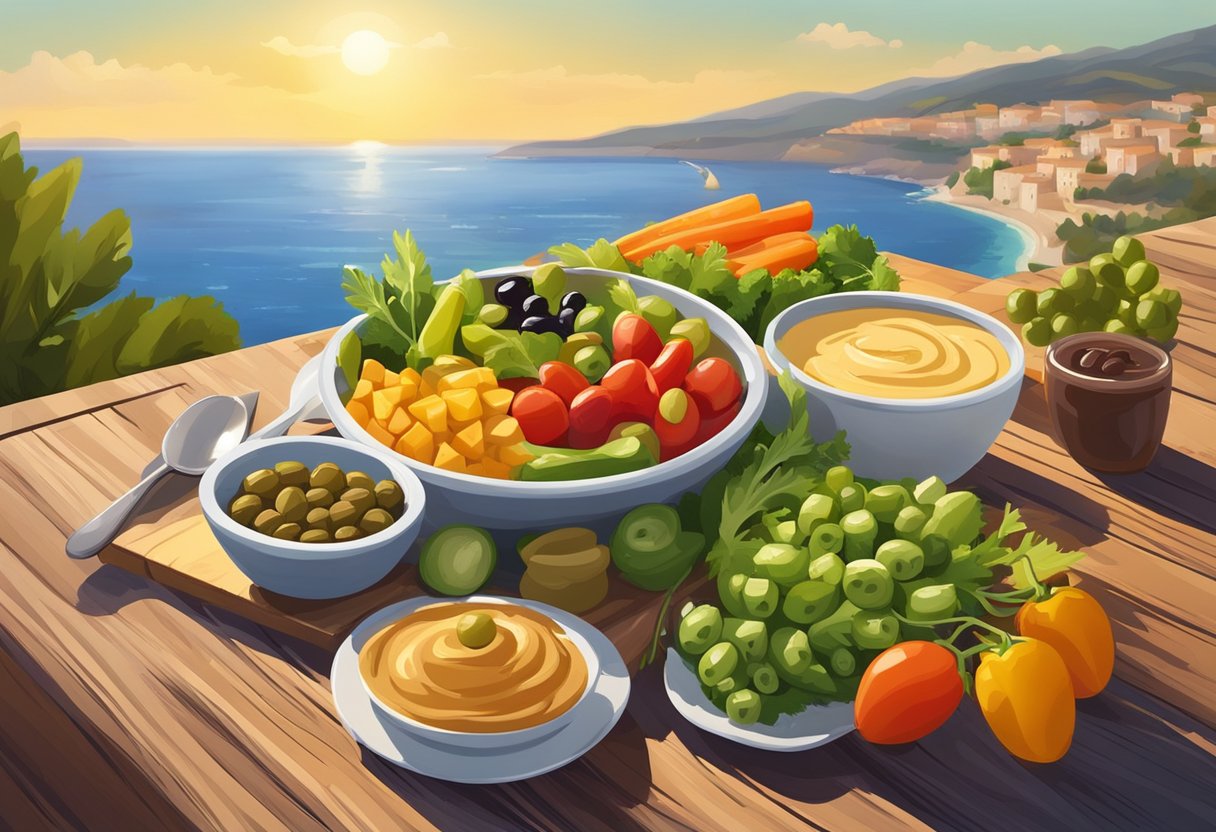
The Mediterranean diet emphasizes communal eating and flavorful vegetable-forward dishes that are perfect for gatherings with friends and family.
Entertaining with Vegetable-Forward Dishes
When planning dinner parties, the gluten-free Mediterranean diet is ideal because of its emphasis on fresh, vibrant vegetables. To be the perfect host, one can create a menu that celebrates these delicious dinners in a way that encourages communal eating. For example, a centerpiece dish might be a colorful array of grilled vegetables, drizzled with olive oil and garnished with fresh herbs, making it not only tasty but also visually appealing.
- Starter: A platter of mixed olives, artichokes, and roasted red peppers.
- Main: Stuffed bell peppers with quinoa, tomatoes, and chickpeas.
- Side: A fragrant tabbouleh salad with fresh parsley and lemon juice.
Presentation is key; use large platters that invite guests to dive in and help themselves, fostering a sense of community.
Sharing Your Creations on Social Media
After perfecting the art of a gluten-free Mediterranean meal, one can take to social media platforms like Instagram to showcase their culinary creations. Sharing photos of vegetable-forward meals can inspire others and offer a peek into the healthy and social lifestyle promoted by the Mediterranean diet. When posting:
Caption Tips:
- Describe the flavors and textures.
- Mention the benefits of a gluten-free Mediterranean diet.
- Use hashtags like #GlutenFreeMediterranean to increase visibility.
Photo Tips:
- Natural lighting enhances the freshness of the ingredients.
- A clean background helps the colors of the dishes pop.
By sharing these culinary experiences, one not only contributes to a larger community but also encourages healthy eating habits among peers.
Frequently Asked Questions
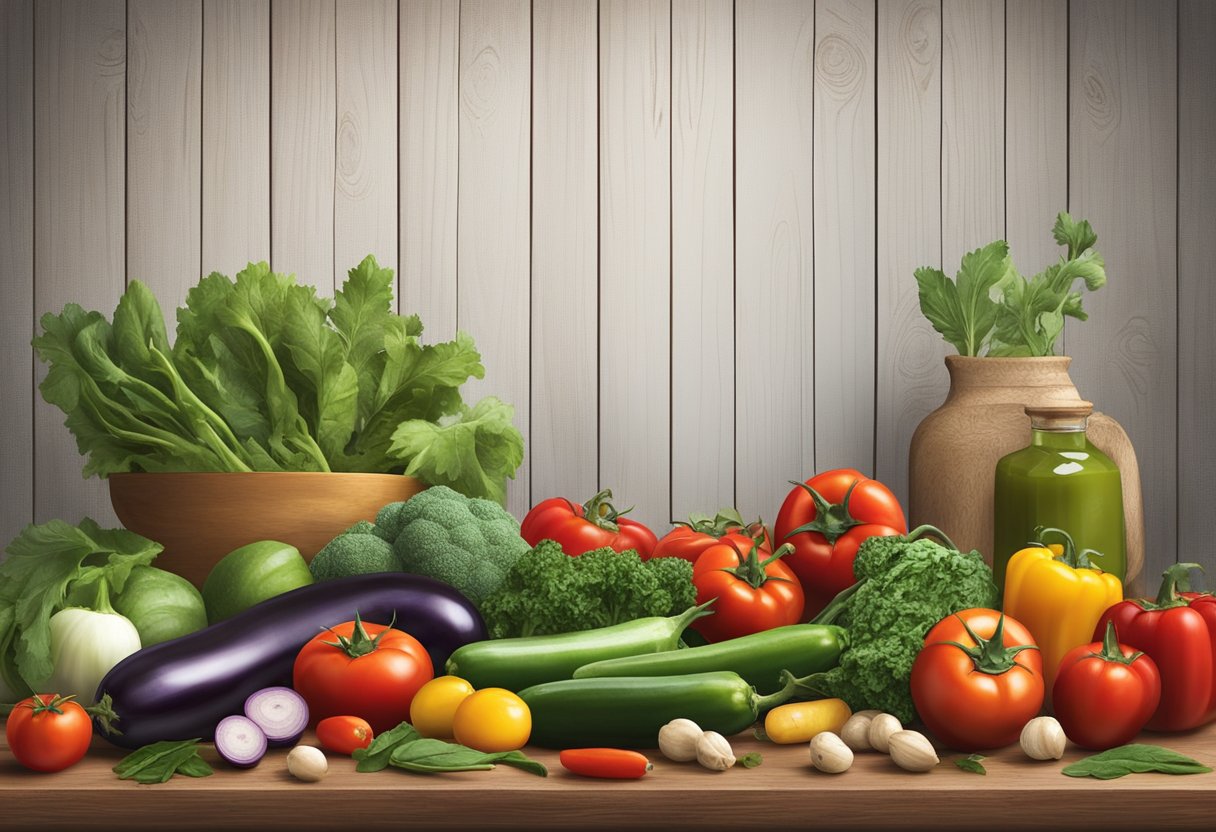
For those adopting a gluten-free Mediterranean diet with a focus on vegetables, these FAQs provide essential information on recipes, meal prep, and planning.
What are some nutritious gluten-free Mediterranean diet recipes featuring vegetables?
There are an array of nutritious recipes that highlight vegetables as the main ingredient, such as grilled vegetable kebabs, roasted butternut squash with quinoa, and Mediterranean stuffed peppers.
Where can I find a comprehensive shopping list tailored to a gluten-free Mediterranean diet?
A comprehensive shopping list for a gluten-free Mediterranean diet can be found that includes vegetables, fruits, nuts, and gluten-free grains to help individuals prepare nutritious meals.
Can you recommend easy-to-prepare vegetable-based meals that align with the gluten-free Mediterranean diet?
Individuals can enjoy easy-to-prepare meals such as ratatouille, a vegetable stir-fry using olive oil, or a Greek salad with a variety of fresh vegetables for a simple and delicious experience.
What are the best resources or cookbooks for gluten-free Mediterranean diet culinary ideas?
One can find culinary ideas and inspiration through resources like the Mayo Clinic Diet website, which offers a dedicated Mediterranean meal plan with gluten-free recipes.
How do I incorporate a variety of vegetables in a balanced gluten-free Mediterranean meal plan?
To incorporate a variety of vegetables, use them as the foundation of meals—start with salads, vegetable soups, or ratatouille, and then add lean proteins or legumes for a balanced meal.
What are some gluten-free and dairy-free breakfast options suitable for the Mediterranean diet?
For breakfast, individuals can enjoy dairy-free Greek yogurt with berries and nuts, avocado toast on gluten-free bread, or omelets with spinach and other vegetables for a nutrient-rich start to the day.



